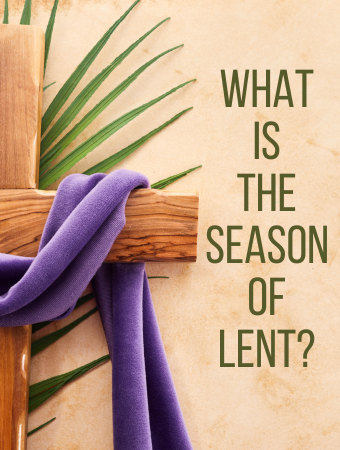“When I look in the Bible, I can’t find anything about Lent or Ash Wednesday. What is Lent? And why is it important to the church?”

BEGIN WITH EASTER
What is Lent?
To understand Lent and Ash Wednesday, let’s start with Easter and back up from there. I think that most people in the church understand that Easter is the celebration of Jesus’ resurrection from the dead. He died on a cross. As a perfect, sinless human, he was punished for the sin of you and me. On the cross, because this human is also the son of God, he became our sin that we might become his righteousness. Easter is Jesus’ triumphant return from the dead. Death itself cannot hold him in the grave, because he is God almighty, who is and was and will be. For the church, Easter is a celebration of the salvation story that God wrote through the life and death of his son.

40 DAYS BEFORE EASTER
What is Lent?
Lent is a man-made season in the church calendar. It is 40 days long. It was created to be 40 days as a reminder of the 40 days that Jesus spent being tempted in the wilderness. Even though Jesus is fully God, he is also fully man. Being fully human, Jesus was tempted as you and I are tempted, and yet he resisted the guile of Satan. When I think of Jesus’ 40 days in the desert, I see that we are different. I cannot persist even one day without sin. He lived a perfect life and then died so that you and I might be redeemed by his perfection.
Lent is then a penitent season where we, as Christians, should consider our need for a sacrifice. Mankind fell into sin. We continue to live in sin. In God’s salvation story, he promised to send a sacrifice to atone for our sin. During Lent, we remember our sin and figuratively wait for the coming sacrifice.
THE FIRST OF 40 DAYS

Ash Wednesday is also a man-made church holiday. It marks the beginning of the season of Lent. By tradition, on Ash Wednesday, a cross is drawn on the forehead. The cross is drawn using ashes. In the Old Testament, ashes are a symbol of repentance. Job 42:6 says, “Therefore I despise myself and repent in dust and ashes.” As another example, after Jonah spoke to the people of Nineveh, the king, “arose from his throne, removed his robe, covered himself with sackcloth, and sat in ashes” (Jonah 3:6). For Ash Wednesday, this Old Testament symbol is given new meaning.
As the cross is drawn upon a forehead, these words from Genesis 3 are spoken, “From dust you came and to dust you shall return.” This is to remind us that the consequence of sin is death. God did not create humanity to die, but as a just God, he judges over sin. Because of our sin, we will die. Our bodies will return to dust. Ash Wednesday reminds us of our need for a savior. We cannot clean ourselves. We cannot save ourselves. On the cross, the son of God became sin for us, to atone for us before God.
For our sake, he made him to be sin who knew no sin, so that in him we might become the righteousness of God.
2 Corinthians 5:21
On Ash Wednesday, we remember our sin, we repent of our sin, and we remember our need for a savior. If you choose not to receive ashes, that’s okay. The ashes do not provide forgiveness. They do not make you more holy before God. They’re a symbol of repentance. They are a visual reminder that our sin creates a need for a savior who can wash us clean.
THE CHRUCH CALENDAR

The liturgical church calendar was designed to provide structure for the church as it pertains to worship. The first half of the church year is known as the “Festival” half. It begins with the season of Advent. All of the “Festival” church holidays follow the life of Christ. So, in Advent, the church waits for the advent, or arrival, of the king. At Christmas, we celebrate the birth of Christ. Epiphany is the day set aside to acknowledge the arrival of the magi. The season of Lent follows Epiphany, beginning with Ash Wednesday. “Holy Week” is the week set aside to recognize the final days of Jesus’ life, from his entrance into Jerusalem to the Last Supper, and finally his death and resurrection.
The second half of the church year begins after Easter. It is known as the “Non-Festival” half of the calendar. The second half reflects Jesus’ teaching rather than particular events in his life. During this time, known broadly as the season of “Pentecost,” the focus is a call to repentance and motivation to witness. The final Sunday of the church year is known as “All Saints Day.” It is a day set aside to recognize those who have died in the faith that church year.
Each of the church seasons has its own color to represent the various events being recognized. There is also a general “mood” that accompanies each season. For example, Advent is anticipatory and joyous, whereas Lent is penitent and somber.
While the seasons of the church year are man-made, they follow biblical events and are designed to point our attention to God’s salvation story, and the work of his son.






Leave a Reply
You must be logged in to post a comment.